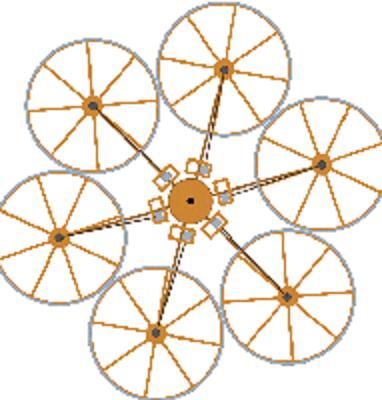Got V8 WM and playing around with pin friction, i notice it's really just applying torque - which of course is all we want from our friction, however it's fundamnetally no different to torque of any other kind, whether using the dedicated 'torque' constraint (as it appears to do anyway) or via the motor constraint.
Torque is torque, is torque. Who cares where it comes from. Not me, that's for sure...
In light of this, i think my suspicions that the motor constraint could've been adding energy were ill-founded - i was just clutching at straws to find any alternative explanation to an asymmetry. It was only inputting negative torque, hence under the bonnet it was braking the wheel in exactly the same way as pin friction in the sim Fletcher provided - it was applying exactly the same force in precisely the same manner.
All this wrangling over what is, ultimately, mere semantics, is completely redundant if one can simply accept that a pure moment can perfectly balance a beam, and that a perfectly balanced beam experiences no change in GPE when rotated.
Even if these two points weren't already axiomatic, i've confirmed them anyway with multiple sims.
Whatever generates our negative torque - a motor or a brake or just a formula - torque is torque; its effect is to reduce the RKE, removing energy from the system.
Hence i think my brake tests were perfectly valid, and the results meaningful.
Coming back to the Mereseburg illustration again -
this one in particular - a number of consistencies can be noted:
Top left corner: beam 4 is suspended from a bearing - the only such bearing in the image, and for some reason copied over from
this image, causing a glaring occlusion error - if the horizontal strut were really for the pendulum to hang on, as ostensibly it is aligned to do so, then why does it terminate in a bearing? This is only consistent with beams 4 forming a swingarm - the out-of-place bearing could mean nothing else..
Also: Could a pendulum drive the alternating flywheel torque, replacing motors and brakes in one fell swoop? It'd still need to apply its effort between the flywheel and beam in order to generate a pure moment - it wouldn't work if you just attached the pendulum to the flywheel directly, or if the pendulum
was the flywheel - but the crank and conrod assembly depicted
would accomplish this, levering the rotor around against the stator, beams 4.
Perhaps Bessler tried both variations - applying torque via a drop weight and pulleys in one machine, and via pendulums in another...
The lock 24 - in the above print, the right-side lock number is inverted to 42... again, this deliberate error would be consistent with a hint at torque reversal. Also, 4 is the beam's number, and 2 is the wheel's... it's crucial that torque has to be applied between them, so maybe "24" represents positive torque, and "42" negative?
Tenuous isn't it - but that's the beauty of confirmation bias i guess. Works for me anyhoo..
Finally, quadrants.. I'd been wondering what's the significance of the upper-left window quadrant in the Meresburg illustrations? But if it's illustrating all the compoents of a pure moment exploit (as i'm suggesting) then perhaps it's a reference to the 90° operating arc of the beam - the rope or water going through one quadrant of the window could be a metaphor for one 90° cycle.
And FWIW if the stampers have any special cryptic meaning i'm currently stumped as to what... the demonstrations
did feature stampers though. But no witnesses record seeing the pendulums. Or the main posts being suspended from a swing bearing..
Steorn haven't got back to me yet. I'll give 'em a week then try a different channel...
But yeah... if i'm making some crass error here i'm still not seeing it.. which is almost as terrifying as it is tantalizing.. All i know is i am going to feel SUCH an idiot if this interaction isn't doing what i currently think it is...


